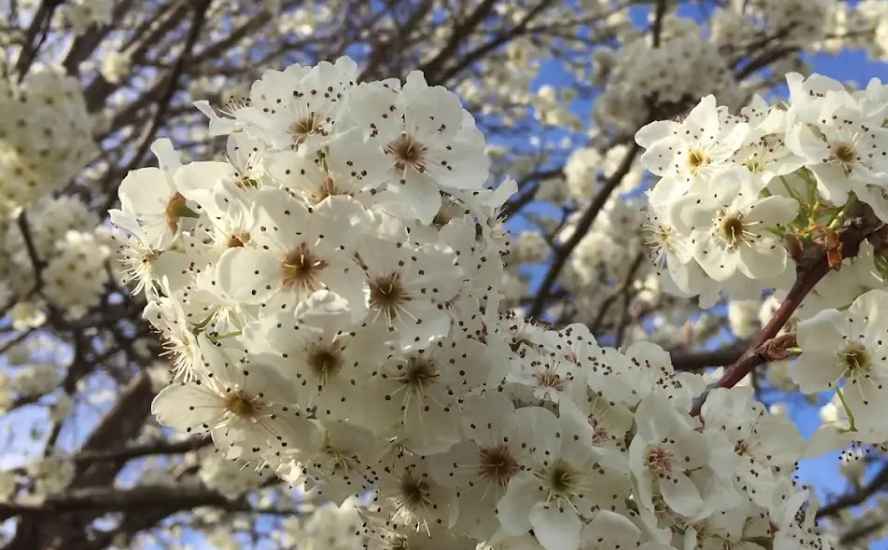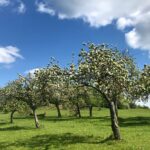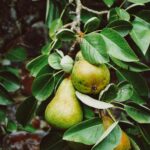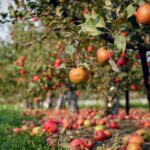Like the ornamental pear tree, a flowering tree is a stunning addition to any landscape. It begins the year with white flowers in spring, followed by dark green foliage in the summer that offers ample shade. As the seasons change, the tree provides a brilliant red display in autumn, and even its winter bark adds a touch of beauty to the garden. This ideal specimen tree is perfect for lawns, driveways, or small spaces, where it can stand out without taking up too much room. Many people prefer non-fruiting trees to avoid the mess that fruit can create, and the showy cultivars of pear trees are a popular choice for such needs.
Also, read my guide on:
How to Prune a Pear Tree: A Simple Guide for Healthy Growth
How to Plant a Gorgeous Dogwood Tree
Whether you want to enhance your yard with a low-maintenance tree or seek a tree that adds color throughout the seasons, the ornamental pear tree fits the bill. It grows beautifully in various settings and does not require much upkeep. It is a favorite among gardeners who appreciate beauty without the hassle of fruit-bearing trees. This tree is especially appealing for those who dislike the fruit but still want to enjoy the aesthetic charm of pear trees in their landscape.
Characteristics of Flowering Pear Tree
| Botanical Name | Pyrus calleryana |
| Common Name | Flowering Pear |
| Plant Type | Deciduous tree |
| Mature Size | 30 to 50 feet |
| Sun Exposure | 6 or more hours of Full sun |
| Soil Type | Moist, well-drained, tolerant of most soils |
| Soil pH | Slightly acidic 6.0-7.5 |
| Bloom Time | Spring |
| Flower Color | White |
| Autumn Foliage | Red |
| Hardiness Zones | 4 to 9 |
| Native Area | China, Vietnam |
Fruiting Pear Trees Vs. Flowering Pear Trees
Ornamental pear trees and fruiting pear trees differ in many ways. Fruiting pear trees are typically known for their edible fruit. Still, the pears are often of small size, usually less than half an inch in diameter. While these fruits are sparse and sometimes non-existent in certain ornamental varieties, they provide a food source for wildlife. On the other hand, flowering pear trees are cultivated for their stunning spring flowers and vibrant autumn colors, but they generally do not produce fruit. These trees are deciduous with deep green, ovate leaves that turn red, bronze, and purple hues in the fall.
Flowering pear trees are favored for their non-existent fruiting or sparse fruit, and they thrive in various soil types, requiring full sun to flourish. These trees are resistant to diseases such as fire blight, oak root fungus, and verticillium wilt, making them a reliable and low-maintenance addition to any landscape. In contrast, fruiting pear trees are more prone to such issues but are highly valued for their edible fruit. The choice between these two types often depends on whether you prefer an aesthetically pleasing tree with little to no fruit or one that provides small fruit for wildlife and harvesting.
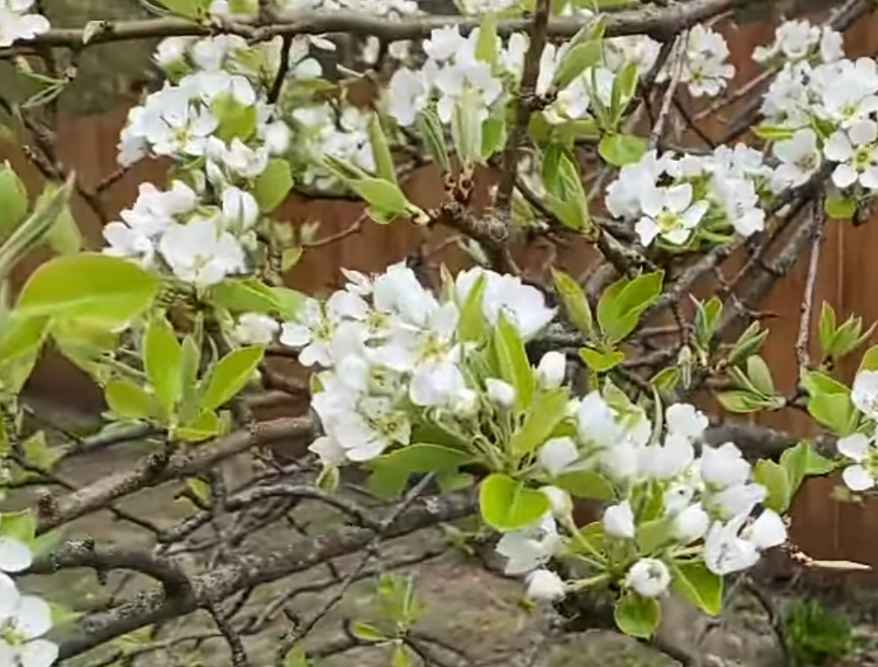
Varieties of Flowering Pear Trees
Aristocrat
The Aristocrat ornamental pear tree is known for its cone-shaped habit and is suited to USDA zones 5-8. It features a high canopy and produces beautiful white flowers in early spring. This tree is an excellent choice for those looking for a tall, narrow tree that can thrive in slightly larger spaces.
Redspire
The Redspire pear tree is another variety with a cone-shaped habit and is well-suited for USDA zones 5-8. Like the Aristocrat, it blooms in early spring with showy white flowers. This variety also grows with a high canopy, adding beauty and shade to any landscape.
Capital
The Capital pear tree has a columnar mien, making it ideal for narrow spaces. Suited for USDA zones 4-8, it offers a more upright growth, reaching heights of up to 35 feet (11 m). This tree is perfect for those looking for a smaller, more structured tree for landscaping.
Chanticleer
The Chanticleer pear tree has a pyramid-like habit and is known for its minimal spread of about 15 feet (5 m). This tree is perfect for smaller yards or tight spaces. It also features spring blooms with white flowers, providing seasonal beauty without requiring too much room.
Bradford
The Bradford ornamental pear tree is a popular variety with horizontal branching systems that can reach up to 40 feet (12 m) in height. It produces vibrant orange-red leaves in the fall and has showy white flowers in early spring. However, it is known for being prone to storm damage and breaking, which led to the nickname Fatford Pear.
Fauer
The Fauer pear tree is the smallest ornamental variety, reaching just 20 feet (6 m). This tree is perfect for smaller spaces, offering a manageable size while still providing beautiful blooms in spring.
Redspire and Aristocrat (Tall Varieties)
The Redspire and Aristocrat pear trees are the tallest ornamental varieties, reaching heights of up to 50 feet (15 m). These trees feature an impressive stature with high canopies and produce stunning blooms, making them an excellent choice for larger landscapes.
Spring vs Winter Blooming
Some varieties of flowering pear trees bloom in spring, while others, like the Redspire, bloom in winter. Choosing the right blooming time for your landscape can provide year-round interest, ensuring beauty during different seasons.
Planting an Ornamental Flowering Pear
Choose the Right Location
Select a spot for your ornamental flowering pear tree that allows enough space for the tree’s mature height of thirty feet and twenty feet wide. Ensure the location has a narrow, upright shape to avoid interference with electrical wiring or structures. It is important to prune regularly to maintain a tidy appearance and avoid a cluttered canopy.
Prepare the Soil
The tree thrives in mountain soil conditions, including alkaline and clay, but prefers slightly acidic, well-drained soil. Its tolerant nature makes it adaptable to more difficult areas where other trees may not survive. Ensure the soil is well-drained for the best growth.
Ensure Proper Sunlight
Choose a location that gets 6+ hours of sun during the growing season. This is necessary to produce the spring flowers and vibrant autumn color that the tree is known for. While seedlings may grow in shadier areas, a sunny spot is ideal for full growth.
Watering the Tree
After planting, water the tree regularly with a garden hose for at least one month. In the summer, increase watering to two months. If automatic irrigation systems are used, monitor them carefully to ensure they are effective, as they may not be sufficient initially. Watering should be done 2x weekly from April to October and 2x monthly from November to March.
Fertilizing the Tree
Feed your flowering pear tree 4x a year using fertilizers such as 7-4-4 all-purpose plant food, soil sulfur, or humic. This ensures the tree stays healthy and grows strong, especially during the first few years.
Pruning and Maintenance
Prune the tree regularly during the first few years to maintain its shape and form. This also helps prevent storm and wind damage and minimizes the risk of disfigurement. Proper pruning ensures that the tree will grow balanced, with no unwanted growth.
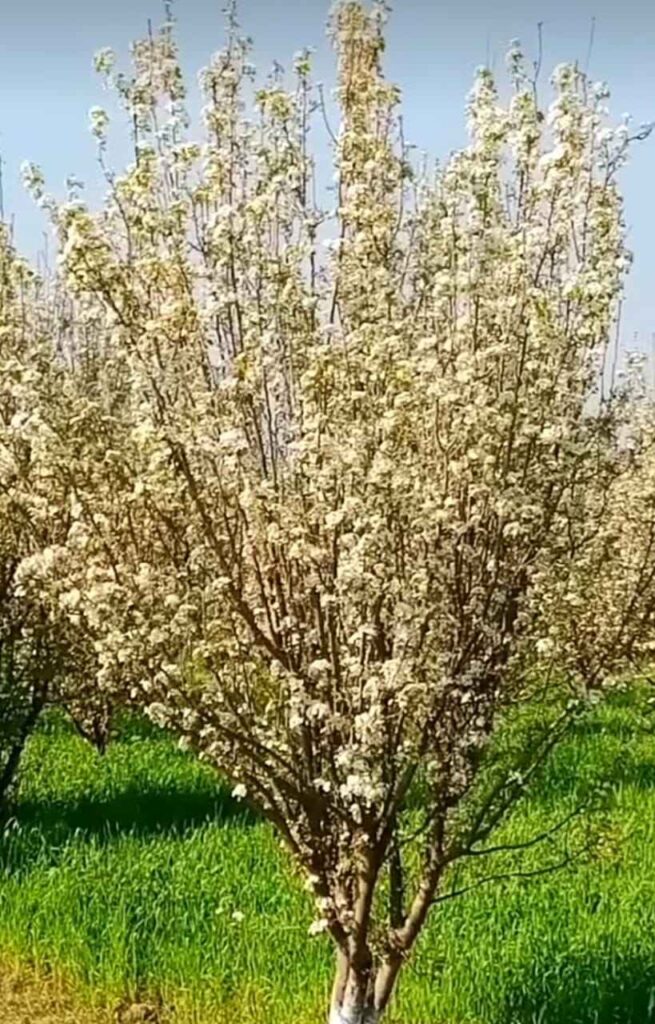
Final Observations
The flowering pear tree is a beautiful and low-maintenance addition to any landscape. Its stunning white flowers in spring, vibrant autumn color, and ability to provide summer shade with dark green foliage make it a year-round focal point. This non-fruit-bearing pear tree offers an aesthetic charm without the hassle of fallen fruit and is perfect for lawns, driveways, or small spaces. Whether you prefer the showy blooms or the tree’s resilience to various soil types and pests, the ornamental pear tree is an excellent choice for gardeners looking to add beauty without requiring extensive care.
FAQs
Q- How tall do flowering pear trees get?
Depending on the variety, flowering pear trees can reach 30 to 50 feet.
Q- What is a flowering pear?
A flowering pear is an ornamental tree known for its white spring flowers and vibrant autumn foliage, typically without significant fruit production.
Q- What is the best type of ornamental pear tree?
Some of the best types of ornamental pear trees include Aristocrat, Redspire, and Capital, which offer various shapes and sizes to fit different landscapes.
Q- What is the difference between a Bradford pear and a flowering pear?
A Bradford pear is a variety of flowering pear known for its horizontal branching and storm damage susceptibility. In contrast, other flowering pear varieties, like cone-shaped or columnar, may have different shapes and are more damage-resistant.
